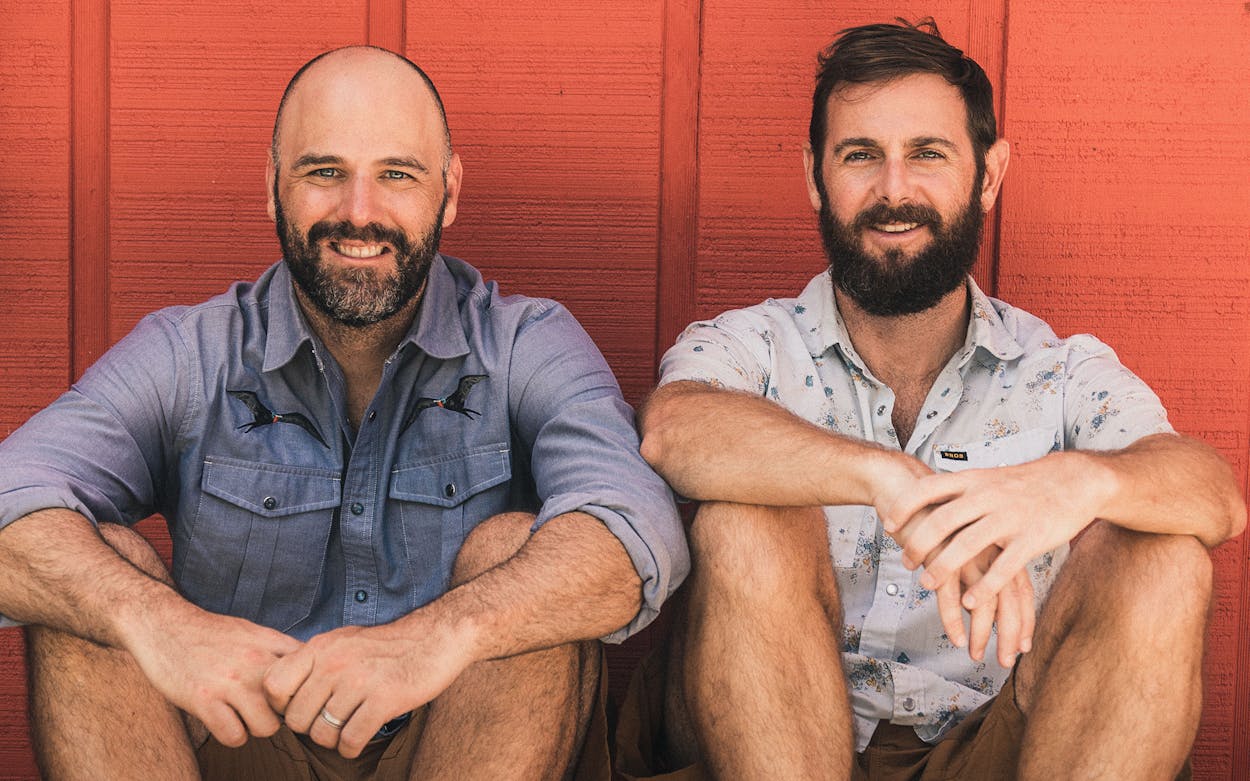Back in 1999, when Chase Heard and Andy Stepanian started a bluegrass band called the Wrinkle Neck Mules, they combed racks at vintage shops looking for classic Western shirts to wear at gigs.
The two musicians, who met at the University of Virginia and bonded over their love of surfing and the outdoors, wore those shirts when they went fishing too, preferring the look over more technical garb. “The uniform was pastel, over-vented, dorky-looking stuff,” Heard said. The way they saw it, Western yokes and pearl snaps, with a splash of surf punk thrown in, just looked better. When the two founded the Howler Brothers apparel company in 2011, they wanted to create clothes that fit their own “ride a horse to the beach then catch a few waves” brand of cool.
Ten years into the company’s existence, the Austin-based “Howlerverse,” with its embroidered gaucho shirts, board shorts, and accompanying fan base, is expanding beyond apparel into a world that encompasses art, music, and film.
Heard, 43, was born in Houston but grew up in Florida, and Stepanian, 46, is from Virginia. Both loved to surf and both embraced the style that surrounded the sport. Their band toured the U.S. for several years in the early aughts, even playing SXSW in Austin. When Heard moved to Austin to get a graduate degree and pursue a career in architecture, they continued to play together.
The duo were always creative, but when a T-shirt company sponsored the band, Heard wanted to design the shirts himself. Instead of forking over the drawings for someone else to produce, he wanted to do it himself. He asked Stepanian to help. “I didn’t have any experience,” Heard said. “It was kind of a gut thing that we were following.” Their DIY ethos carried over from music to clothing, as they screen-printed one hundred at a time of each new design and found success in the niche market of fly fishermen with a fashion sense. Howler Brothers was born.
The name came from the roar of howler monkeys, the soundtrack of surf trips the friends had taken to Costa Rica. They added “brothers” to allude to their connection as friends. Their mantra became “Heed the call.”
Initially, Heard worked from his garage in Central Austin, where he sketched out designs and stashed products to sell online. “At first, it was just me and my wife Helen and our two little babies,” he said. “We’d pack goods, write handwritten notes, and load them into the kids’ stroller to take them to the post office.”
They started with T-shirts, polo shirts, and long-sleeved sun shirts, designed for customers who liked recreating outdoors. The company’s signature gaucho shirt, which features embroidered designs of alligators, crawfish, pelicans, piñatas, and other designs above the front pockets, came a few years later. At the time, the style felt like a risk. “We wanted to make something that didn’t look like a mango that got into a knife fight,” Stepanian said. “Something you could use for a day on the water or go for a hike and roll right out and nobody’s going to go, ‘Oh my God, that’s a fishing shirt.’”
Today the company releases three or four new gaucho designs every spring. Some sell out and are never revived; some make longer appearances. They cost $99 new, but discontinued designs can draw three or four times that much on eBay from collectors determined to own every single gaucho design ever created.
“It’s our most famous item,” Heard said. “It’s very identifiable and there’s a whole cult around them. People will call and send a spreadsheet of all the gauchos they have and which ones they’re missing.”
Actors Matthew McConaughey and Will Ferrell wear Howler Brothers gauchos. Comedian Jimmy Kimmel wanted the squirrel design, but it sold out before he nabbed one. “He told us, ‘If you ever make one with slices of pizza, I’ll buy it,’” Heard said. They made him one, and Kimmel wore it on his TV show.
“Luckily for us, we weren’t the only ones in the world who seemed to think what we were doing was cool. A community started to grow around what we did, and that community goes beyond just people wearing the shirts,” Heard said.
Howler fans seemed to share a love of music, the outdoors, and that funky mash-up of surfer and Western design. They felt such a strong connection to the company that some began asking its founders to their weddings. Others sent photos of tattoos they’d gotten of Howler Brother designs.
The company moved from Heard’s garage into a warehouse. Heard and Stepanian brought on two more partners (Mason Brent, who plays guitar in the Wrinkle Neck Mules, and Rick Wittenbraker, who had worked at Yeti), and opened headquarters and retail shops in Austin.
Today, the company makes pants, jackets, hoodies, hats, board shorts, and vests. “We always talk about things like, ‘That’s cool but we need to make it more Howler-y,’ or ‘This is not Howler-fied enough.’ We don’t know exactly what that is, except we know it when we see it,” Stepanian said.
One thing they don’t make is women’s clothing. “We don’t want to just shrink it and pink it—make it smaller and pastel-y,” Stepanian said. “We’re going to get there, but we’re not there yet.”
As the company moves forward, its offerings are become more eclectic. You can buy a Howler Brothers surfboard or flip through a copy of a Howler Brothers coffee-table book. You can still hear the Wrinkle Neck Mules perform occasionally, or catch a show by Leon III, a psychedelic group headed by Stepanian and Mason.
“We’ve got a real desire to change and evolve and do more things,” Stepanian says. “In the music world it’s that way. You can’t just rest on laurels, you’ve got to add a drum machine.”
- More About:
- Style & Design
- Fashion






